Development of Genistein Drug Delivery Systems Based on Bacterial Nanocellulose for Potential Colorectal Cancer Chemoprevention: Effect of Nanocellulose Surface Modification on Genistein Adsorption
Abstract
1. Introduction
2. Results
2.1. Calculation of Inhibitory Concentration (IC50) for Free Genistein
2.2. Development of BNC and BNC-CTAB Materials
2.3. Adsorption Studies
2.3.1. Adsorption Isotherms
2.3.2. Determination of Thermodynamic Parameters
2.3.3. Adsorption Kinetics
2.4. Development of Thin Film Drug Delivery System and Characterization
2.5. In Vitro Release Study in Gastrointestinal Fluids
3. Discussion
4. Materials and Methods
4.1. Materials
4.2. Calculation of Inhibitory Concentration (IC50) for Free Genistein
4.3. Development of BNC and BNC-CTAB Materials
4.3.1. BNC Synthesis
4.3.2. BNC Surface Modification
4.3.3. Morphological Analysis
4.3.4. Contact Angle Measurements
4.3.5. Chemical Analysis
4.3.6. Thermal Analysis
4.4. Adsorption Studies
4.4.1. Genistein Quantification
4.4.2. Adsorption Isotherms
4.4.3. Determination of Thermodynamic Parameters
4.4.4. Adsorption kinetics
- Pseudo-first-order—This model assumes that there is an adsorption site in the adsorbent for each adsorbate molecule. The kinetics are described by the following equation [53],
4.5. Development of Thin-Film Drug Delivery Systems
Thin Films’ Characterization
4.6. In Vitro Gastrointestinal Fluids Release Study
5. Conclusions
Author Contributions
Funding
Institutional Review Board Statement
Data Availability Statement
Conflicts of Interest
Sample Availability
Appendix A
| Isotherm Models | BNC-GEN | BNC-CTAB-GEN | |||||
|---|---|---|---|---|---|---|---|
| 0 °C | 23 °C | 40 °C | 0 °C | 23 °C | 40 °C | ||
| BET | Qm (mg·g−1) | 3.08 | 3.66 | 3.11 | 3.501 | 3.8613 | 2.848 |
| CBET | 1.00 | 1.00 | 1.00 | 0.999 | 0.9998 | 1.000 | |
| CS (mg·L−1) | 0.02 | 0.00 | 0.03 | 0.026 | 0.0171 | 0.001 | |
| R2 | 0.96 | 0.96 | 0.95 | 0.792 | 0.8455 | 0.659 | |
| FHH | AFHH | 0.568 | 1.00 | 0.90 | 1.00 | 0.25 | 0.89 |
| BFHH | 7.780 | 1.00 | 1.90 | 2.31 | 1.00 | 2.00 | |
| CS (mg·L−1) | 0.299 | 25.00 | 0.50 | 29.57 | 0.70 | 25.24 | |
| R2 | −6.702 | −2.17 | −1.93 | −5.06 | −5.23 | −1.92 | |
| GAB | QmGAB (mg·g−1) | 0.45 | 0.34 | 0.00 | 0.28 | 1.00 | 1.00 |
| CGAB | 11,060.30 | 6228.31 | 1.37 | 43.98 | 12.15 | 1.00 × 108 | |
| KG | 328.404 | 0.01 | 0.99 | 0.18 | 1.24 | 1.16 × 108 | |
| CS (mg·L−1) | 3053.60 | 0.10 | 0.89 | 2.00 | 0.634 | 0.03 | |
| R2 | −4.68 | 6.83 | −5.63 | −3.28 | −5.19 | −4.48 | |
Appendix B
| Model | Parameters | Description |
|---|---|---|
| BET | , maximum adsorption capacity corresponding to the monolayer saturation (mg∙g−1). , saturation concentration of the monolayer (mg∙L−1). , model constant. | Assumes a uniform surface and homogeneous adsorption energy at all sites. The second, third, and other layers have adsorption energies equal to the enthalpy of fusion. |
| FHH | , model constant. , model constant. | Assumes the variation in adsorption potential based on the distance between adsorbent and molecule. Additionally, accepts that surface heterogeneity affects all the layers. |
| GAB | , maximum adsorption capacity corresponding to the monolayer (mg∙g−1). , model constant. , model constant. | This model includes the parameter to differentiate the chemical potential between the molecules of the second and subsequent layers and molecules in the liquid state. |
References
- Organisatión Mondiale de la Santé (OMS). Enfermedades no Transmisibles. 2018. Available online: https://www.who.int/es/news-room/fact-sheets/detail/noncommunicable-diseases (accessed on 28 April 2020).
- International Agency for Research on Cancer. Cancer Today. Global Cancer Observatory. Available online: https://gco.iarc.fr/today/online-analysis-dual-bars-2?v=2020&mode=cancer&mode_population=regions&population=900&populations=900&key=crude_rate&sex=0&cancer=39&type=0&statistic=5&prevalence=0&population_group=0&ages_group%5B%5D=0&ages_group%5B%5D=17&nb_ite (accessed on 13 January 2021).
- GLOBOCAN—World Health Organization (WHO). Estimated number of deaths in 2020, both sexes, all ages. Int. Agency Res. Cancer 2020, 144, 100. [Google Scholar]
- Pointet, A.-L.; Taieb, J. Manual AEC Cirugía Colorrectal. Capítulo 20: Cáncer de colon. In Colloids and Surfaces A: Physicochemical and Engineering Aspects; Elsevier B.V.: Amsterdam, The Netherlands, 2017; Volume 21, pp. 213–228. [Google Scholar]
- Cáncer de Colon—Diagnóstico y Tratamiento. Mayo Clinic. 2019. Available online: https://www.mayoclinic.org/es-es/diseases-conditions/colon-cancer/diagnosis-treatment/drc-20353674 (accessed on 8 June 2020).
- Pool, H.; Campos-Vega, R.; Herrera-Hernández, M.G.; García-Solis, P.; García-Gasca, T.; Sánchez, I.C.; Luna-Bracenas, G.; Vergara-Castaneda, H. Development of genistein-PEGylated silica hybrid nanomaterials with enhanced antioxidant and antiproliferative properties on HT29 human colon cancer cells. Am. J. Transl. Res. 2018, 10, 2306–2323. [Google Scholar] [PubMed]
- Zhu, J.; Ren, J.; Tang, L. Genistein inhibits invasion and migration of colon cancer cells by recovering WIF1 expression. Mol. Med. Rep. 2018, 17, 7265–7273. [Google Scholar] [CrossRef] [PubMed]
- Abotaleb, M.; Samuel, S.M.; Varghese, E.; Varghese, S.; Kubatka, P.; Liskova, A.; Büsselberg, D. Flavonoids in cancer and apoptosis. Cancers 2019, 11, 28. [Google Scholar] [CrossRef]
- Dixon, R.A.; Ferreira, D. Genistein. Phytochemistry 2002, 60, 205–211. [Google Scholar] [CrossRef]
- Mukund, V.; Mukund, D.; Sharma, V.; Mannarapu, M.; Alam, A. Genistein: Its role in metabolic diseases and cancer. Crit. Rev. Oncol. Hematol. 2017, 119, 13–22. [Google Scholar] [CrossRef]
- Jerez, M.H. Antocianos: Metabolismo y Actividad Biológica. Ph.D. Thesis, Universidad Complutense de Madrid, Madrid, Spain, 2013. Available online: https://eprints.ucm.es/20093/1/T34345.pdf (accessed on 12 June 2020).
- Wang, Y.; Wang, Y.; Liu, Y.; Liu, Q.; Jang, J.; Han, J. Preparation, characterization, and antioxidant activities of cellulose nanocrystals/genistein nanocomposites. BioResources 2019, 14, 336–348. [Google Scholar] [CrossRef]
- Jaiswal, N.; Akhtar, J.; Singh, S.P.; Ahsan, F. An Overview on Genistein and its Various Formulations. Drug Res. 2019, 69, 305–313. [Google Scholar] [CrossRef]
- Rahmani, F.; Karimi, E.; Oskoueian, E. Synthesis and characterisation of chitosan-encapsulated genistein: Its anti-proliferative and anti-angiogenic activities. J. Microencapsul. 2020, 37, 305–313. [Google Scholar] [CrossRef]
- De Barud, H.G.; da Silva, R.R.; da Silva Barud, H.; Tercjak, A.; Gutierrez, J.; Lustri, W.R.; de Oliveira, O.B.J.; Ribeiro, S.J.L. A multipurpose natural and renewable polymer in medical applications: Bacterial cellulose. Carbohydr. Polym. 2016, 153, 406–420. [Google Scholar] [CrossRef]
- Osorio, M.; Cañas, A.; Puerta, J.; Díaz, L.; Naranjo, T.; Ortiz, I.; Castro, C. Ex Vivo and In Vivo Biocompatibility Assessment (Blood and Tissue) of Three-Dimensional Bacterial Nanocellulose Biomaterials for Soft Tissue Implants. Sci. Rep. 2019, 9, 10553. [Google Scholar] [CrossRef] [PubMed]
- Al Balawi, A.N. Antioxidative Response Mechanisms of Nanocelluloses and Nanohydrogels Matrices: A Review; INC: Geneva, Switzerland, 2020. [Google Scholar]
- Perez, M.A. La Nanocelulosa Desafía al Grafeno como Nuevo Material Prodigio. 2013. Available online: https://blogthinkbig.com/nanocelulosa-grafeno-material-prodigio (accessed on 28 April 2020).
- Osorio, M.; Velásquez-Cock, J.; Restrepo, L.M.; Zuluaga, R.R.; Gañán, P.; Rojas, O.J.; Ortiz-Trujillo, I.; Castro, C. Bioactive 3D-Shaped Wound Dressings Synthesized from Bacterial Cellulose: Effect on Cell Adhesion of Polyvinyl Alcohol Integrated In Situ. Int. J. Polym. Sci. 2017, 2017, 3728485. [Google Scholar] [CrossRef]
- Zuluaga Gallego, R.O.; Serpa Guerra, A.M.; Velez Acosta, L.M.; Gómez Hoyos, C.; Castro Herazo, C.I.; Casas Botero, A.E.; Osorio Delgado, A.M.; Velazquez Cock, J.; Torres Taborda, M.M.; Gañán Rojo, P.F.; et al. La nanocelulosa: Una estructura producida por la naturaleza. In Nanotecnología, Fundamentos y Aplicaciones; Álvarez-Láinez, M.L., Martínez-Tejada, H.V., Jaramillo Isaza, F., Eds.; Editorial Universidad de Antioquia: Medellín, Colombia, 2019; pp. 99–111. [Google Scholar]
- Cacicedo, M.L.; León, I.E.; Gonzalez, J.S.; Porto, L.M.; Alvarez, V.A.; Castro, G.R. Modified bacterial cellulose scaffolds for localized doxorubicin release in human colorectal HT-29 cells. Colloids Surf. B Biointerfaces 2016, 140, 421–429. [Google Scholar] [CrossRef]
- Subtaweesin, C.; Woraharn, W.; Taokaew, S.; Chiaoprakobkij, N.; Sereemaspun, A.; Phisalaphong, M. Characteristics of Curcumin-Loaded Bacterial Cellulose Films and Anticancer Properties against Malignant Melanoma Skin Cancer Cells. Appl. Sci. 2018, 8, 1188. [Google Scholar] [CrossRef]
- Putro, J.N.; Ismadji, S.; Gunarto, C.; Yuliana, M.; Santoso, S.P.; Soetaredjo, F.E.; Ju, Y.H. The effect of surfactants modification on nanocrystalline cellulose for paclitaxel loading and release study. J. Mol. Liq. 2019, 282, 407–414. [Google Scholar] [CrossRef]
- Akagi, S.; Ando, H.; Fujita, K.; Shimizu, T.; Ishima, Y.; Tajima, K.; Matsushima, T.; Kusano, T.; Ishida, T. Therapeutic efficacy of a paclitaxel-loaded nanofibrillated bacterial cellulose (PTX/NFBC) formulation in a peritoneally disseminated gastric cancer xenograft model. Int. J. Biol. Macromol. 2021, 174, 494–501. [Google Scholar] [CrossRef] [PubMed]
- Qu, J.; Yuan, Z.; Wang, C.; Wang, A.; Liu, X.; Wei, B.; Wen, Y. Enhancing the redispersibility of TEMPO-mediated oxidized cellulose nanofibrils in N,N-dimethylformamide by modification with cetyltrimethylammonium bromide. Cellulose 2019, 26, 7769–7780. [Google Scholar] [CrossRef]
- Qin, J.; Chen, J.X.; Zhu, Z.; Teng, J.A. Genistein inhibits human colorectal cancer growth and suppresses MiR-95, Akt and SGK1. Cell. Physiol. Biochem. 2015, 35, 2069–2077. [Google Scholar] [CrossRef]
- Chen, X.; Gu, J.; Wu, Y.; Liang, P.; Shen, M.; Xi, J.; Qin, J. Clinical characteristics of colorectal cancer patients and anti-neoplasm activity of genistein. Biomed. Pharmacother. 2020, 124, 109835. [Google Scholar] [CrossRef]
- Shafiee, G.; Saidijam, M.; Tavilani, H.; Ghasemkhani, N.; Khodadadi, I. Genistein Induces Apoptosis and Inhibits Proliferation of HT29 Colon Cancer Cells. Int. J. Mol. Cell. Med. 2016, 5, 178–191. Available online: https://www.ncbi.nlm.nih.gov/pmc/articles/PMC5125370/ (accessed on 10 June 2022).
- Gómez, R.L.; Moreno, Q.G.; Herrera, R.A.; Castrillón, L.W.; Yepes, A.F.; Cardona, G.W. New hybrid scaffolds based on ASA/genistein: Synthesis, cytotoxic effect, molecular docking, drug-likeness, and in silico ADME/Tox modeling. J. Appl. Pharm. Sci. 2022, 12, 15–30. [Google Scholar] [CrossRef]
- Tong, Y.; Wang, M.; Huang, H.; Zhang, J.; Huang, Y.; Chen, Y.; Pan, H. Inhibitory effects of genistein in combination with gefitinib on the hepatocellular carcinoma Hep3B cell line. Exp. Ther. Med. 2019, 18, 3793–3800. [Google Scholar] [CrossRef] [PubMed]
- Susanikova, I.; Puchl’Ová, M.; Lachová, V.; Švajdlenka, E.; Mučaji, P.; Smetana, K.; Gál, P. Genistein and selected phytoestrogen-containing extracts differently modulate antioxidant properties and cell differentiation: An in vitro study in NIH-3T3, HaCaT and MCF-7 cells. Folia Biol. 2019, 65, 24–35. [Google Scholar]
- Ly, M. Hydrophobic Modifications of Cellulose Nanocrystals for Anticorrosion and Polymer Coating Applications. Master’s Thesis, University of Waterloo, Waterloo, ON, Canada, 2020. [Google Scholar]
- Rauniyar, B.S.; Bhattarai, A. Study of conductivity, contact angle and surface free energy of anionic (SDS, AOT) and cationic (CTAB) surfactants in water and isopropanol mixture. J. Mol. Liq. 2021, 323, 114604. [Google Scholar] [CrossRef]
- Çiftçi, H.; Ersoy, B.; Evcin, A. Purification of Turkish Bentonites and Investigation of the Contact Angle, Surface Free Energy and Zeta Potential Profiles of Organo-Bentonites as a Function of Ctab Concentration. Clays Clay Miner. 2020, 68, 250–261. [Google Scholar] [CrossRef]
- Abdel-Halim, E.S. Chemical modification of cellulose extracted from sugarcane bagasse: Preparation of hydroxyethyl cellulose. Arab. J. Chem. 2014, 7, 362–371. [Google Scholar] [CrossRef]
- Castro, C.; Zuluaga, R.; Putaux, J.L.; Caro, G.; Mondragon, I.; Gañán, P. Structural characterization of bacterial cellulose produced by Gluconacetobacter swingsii sfrom Colombian agroindustrial wastes. Carbohydr. Polym. 2011, 84, 96–102. [Google Scholar] [CrossRef]
- Zainuddin, N.; Ahmad, I.; Kargarzadeh, H.; Ramli, S. Hydrophobic kenaf nanocrystalline cellulose for the binding of curcumin. Carbohydr. Polym. 2017, 163, 261–269. [Google Scholar] [CrossRef]
- Saadi, R.; Saadi, Z.; Fazaeli, R.; Fard, N.E. Monolayer and multilayer adsorption isotherm models for sorption from aqueous media. Korean J. Chem. Eng. 2015, 32, 787–799. [Google Scholar] [CrossRef]
- Sheela, T.; Nayaka, Y.A.; Viswanatha, R.; Basavanna, S.; Venkatesha, T.G. Kinetics and thermodynamics studies on the adsorption of Zn(II), Cd(II) and Hg(II) from aqueous solution using zinc oxide nanoparticles. Powder Technol. 2012, 217, 163–170. [Google Scholar] [CrossRef]
- Lyubchik, S.; Lyubchik, A.; Lygina, O.; Lyubchik, S.; Fonseca, I. Comparision of the thermodynamic parameters estimation for the adsorption process of the metals from liquid phase on activated carbons. In Thermodynamics, Interaction Studies, Solids, Liquids and Gases; IntechOpen: London, UK, 2020; pp. 95–122. [Google Scholar]
- Scheufele, F.B.; Módenes, A.N.; Borba, C.E.; Ribeiro, C.; Espinoza-Quiñones, F.R.; Bergamasco, R.; Pereira, N.C. Monolayer-multilayer adsorption phenomenological model: Kinetics, equilibrium and thermodynamics. Chem. Eng. J. 2016, 284, 1328–1341. [Google Scholar] [CrossRef]
- Adebayo, G.B.; Jamiu, W.; Okoro, H.K.; Okeola, F.O.; Adesina, A.K.; Feyisetan, O.A. Kinetics, thermodynamics and isothermal modelling of liquid phase adsorption of methylene blue onto moringa pod husk activated carbon. South African J. Chem. 2019, 72, 263–273. [Google Scholar] [CrossRef]
- Sahoo, T.R.; Prelot, B. Adsorption Processes for the Removal of Contaminants from Wastewater: The Perspective Role of nanomaterials and Nanotechnology; Elsevier Inc.: Amsterdam, The Netherlands, 2020. [Google Scholar]
- Adepu, S.; Khandelwal, M. Ex-situ modification of bacterial cellulose for immediate and sustained drug release with insights into release mechanism. Carbohydr. Polym. 2020, 249, 116816. [Google Scholar] [CrossRef] [PubMed]
- Wang, H.; Li, Q.; Chen, H. Genistein affects histone modifications on Dickkopf-related protein 1 (DKK1) gene in SW480 human colon cancer cell line. PLoS ONE 2012, 7, e40955. [Google Scholar] [CrossRef] [PubMed]
- Sun, J.; Li, M.; Lin, T.; Wang, D.; Chen, J.; Zhang, Y.; Mu, Q.; Su, H.; Wu, N.; Liu, A.; et al. Cell cycle arrest is an important mechanism of action of compound Kushen injection in the prevention of colorectal cancer. Sci. Rep. 2022, 12, 4384. [Google Scholar] [CrossRef] [PubMed]
- Castro, C.; Zuluaga, R.; Álvarez, C.; Putaux, J.-L.; Caro, G.; Rojas, O.J.; Mondragon, I.; Gañán, P. Bacterial cellulose produced by a new acid-resistant strain of Gluconacetobacter genus. Carbohydr. Polym. 2012, 89, 1033–1037. [Google Scholar] [CrossRef] [PubMed]
- Syverud, K.; Xhanari, K.; Chinga-Carrasco, G.; Yu, Y.; Stenius, P. Films made of cellulose nanofibrils: Surface modification by adsorption of a cationic surfactant and characterization by computer-assisted electron microscopy. J. Nanoparticle Res. 2011, 13, 773–782. [Google Scholar] [CrossRef]
- Liu, W.; Zhang, S.; Zu, Y.-G.; Fu, Y.-J.; Ma, W.; Zhang, D.-Y.; Kong, Y.; Li, X.-J. Preliminary enrichment and separation of genistein and apigenin from extracts of pigeon pea roots by macroporous resins. Bioresour. Technol. 2010, 101, 4667–4675. [Google Scholar] [CrossRef]
- Agudelo, C.D.; Arango, S.; Cortes-Mancera, F.; Rojano, B.; Maldonado, M.E. Antiproliferative and pro-apoptotic effects of Andean berry juice (Vaccinium meridionale Swartz) on human colon adenocarcinoma SW480 cells. J. Med. Plants Res. 2017, 11, 393–402. [Google Scholar] [CrossRef][Green Version]
- Bertrand, D.; Bertrand, S.; Ballivet, M. Pharmacological properties of the homomeric α7 receptor. Neurosci. Lett. 1992, 146, 87–90. [Google Scholar] [CrossRef]
- Cañas-Gutiérrez, A.; Martinez-Correa, E.; Suárez-Avendaño, D.; Arboleda-Toro, D.; Castro-Herazo, C. Influence of bacterial nanocellulose surface modification on calcium phosphates precipitation for bone tissue engineering. Cellulose 2020, 27, 10747–10763. [Google Scholar] [CrossRef]
- Figueroa, D.; Moreno, A.; Hormaza, A. Equilibrio, termodinámica y models cinéticos en la adsorción de Rojo 40 sobre tuza de maíz. Rev. Ing. Univ. Medellín 2015, 14, 105–120. [Google Scholar] [CrossRef]
- Pérez, N.; González, J.; Delgado, L.A. Estudio termodinámico del proceso de adsorción de iones de ni Y V por parte de ligninas precipitadas del licor negro kraft. Rev. Latinoam. Metal. Mater. 2011, 31, 168–181. [Google Scholar]
- Zhang, W.; An, Y.; Li, S.; Liu, Z.; Chen, Z.; Ren, Y.; Wang, S.; Zhang, X.; Wang, X. Enhanced heavy metal removal from an aqueous environment using an eco-friendly and sustainable adsorbent. Sci. Rep. 2020, 10, 16453. [Google Scholar] [CrossRef] [PubMed]
- Tejada, C.; Herrera, A.; Ruiz, E. Kinetic and isotherms of biosorption of Hg(II) using citric acid treated residual materials. Ing. Compet. 2016, 18, 113. [Google Scholar] [CrossRef]
- Kavitha, D.; Namasivayam, C. Experimental and kinetic studies on methylene blue adsorption by coir pith carbon. Bioresour. Technol. 2007, 98, 14–21. [Google Scholar] [CrossRef]
- Xiao, Y.; Ho, C.-T.; Chen, Y.; Wang, Y.; Wei, Z.; Dong, M.; Huang, Q. Synthesis, Characterization, and Evaluation of Genistein-Loaded Zein/Carboxymethyl Chitosan Nanoparticles with Improved Water Dispersibility, Enhanced Antioxidant Activity, and Controlled Release Property. Foods 2020, 9, 1604. [Google Scholar] [CrossRef]
- Shehata, E.M.M.; Elnaggar, Y.S.R.; Galal, S.; Abdallah, O.Y. Self-emulsifying phospholipid pre-concentrates (SEPPs) for improved oral delivery of the anti-cancer genistein: Development, appraisal and ex-vivo intestinal permeation. Int. J. Pharm. 2016, 511, 745–756. [Google Scholar] [CrossRef]
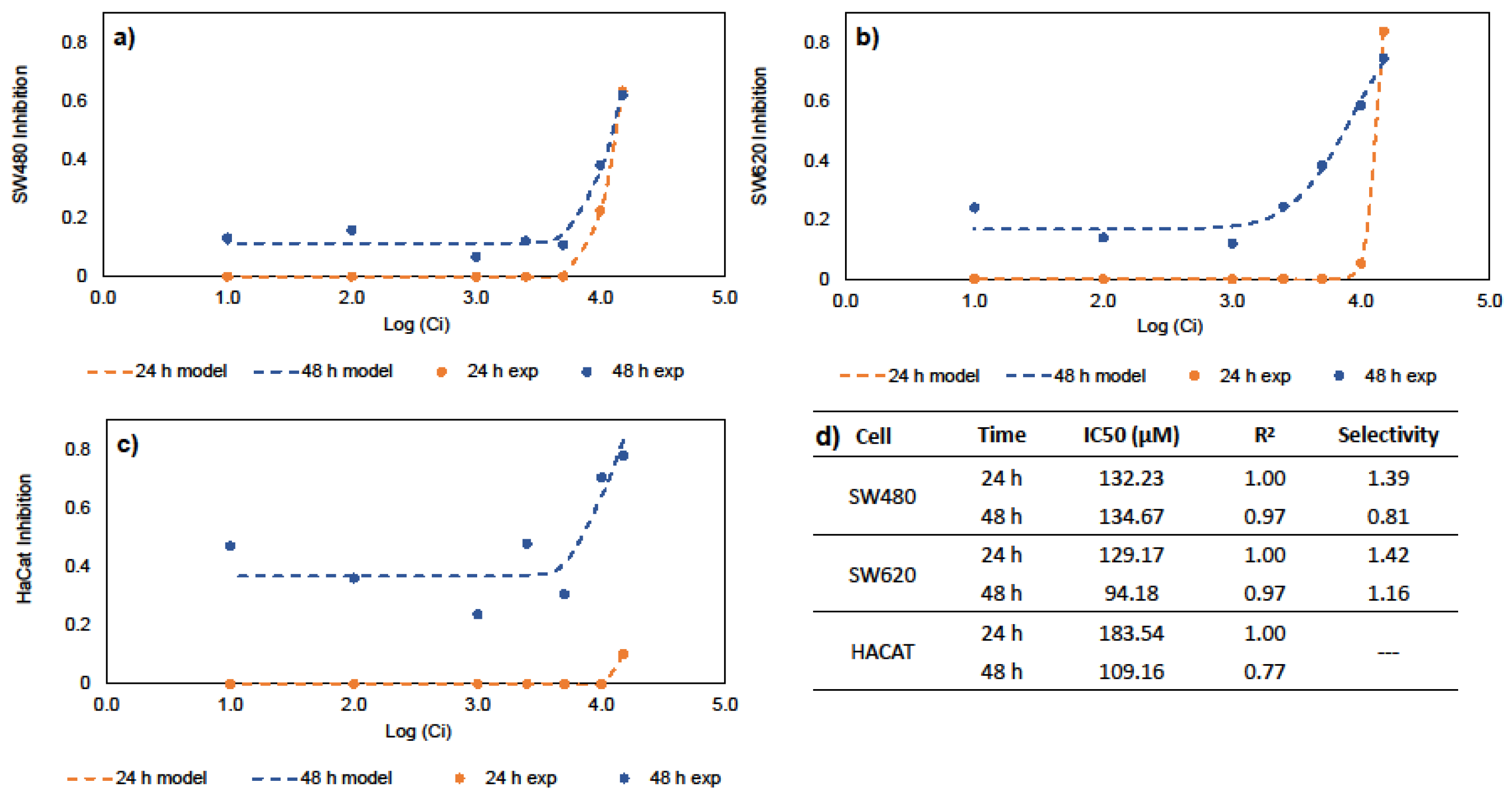
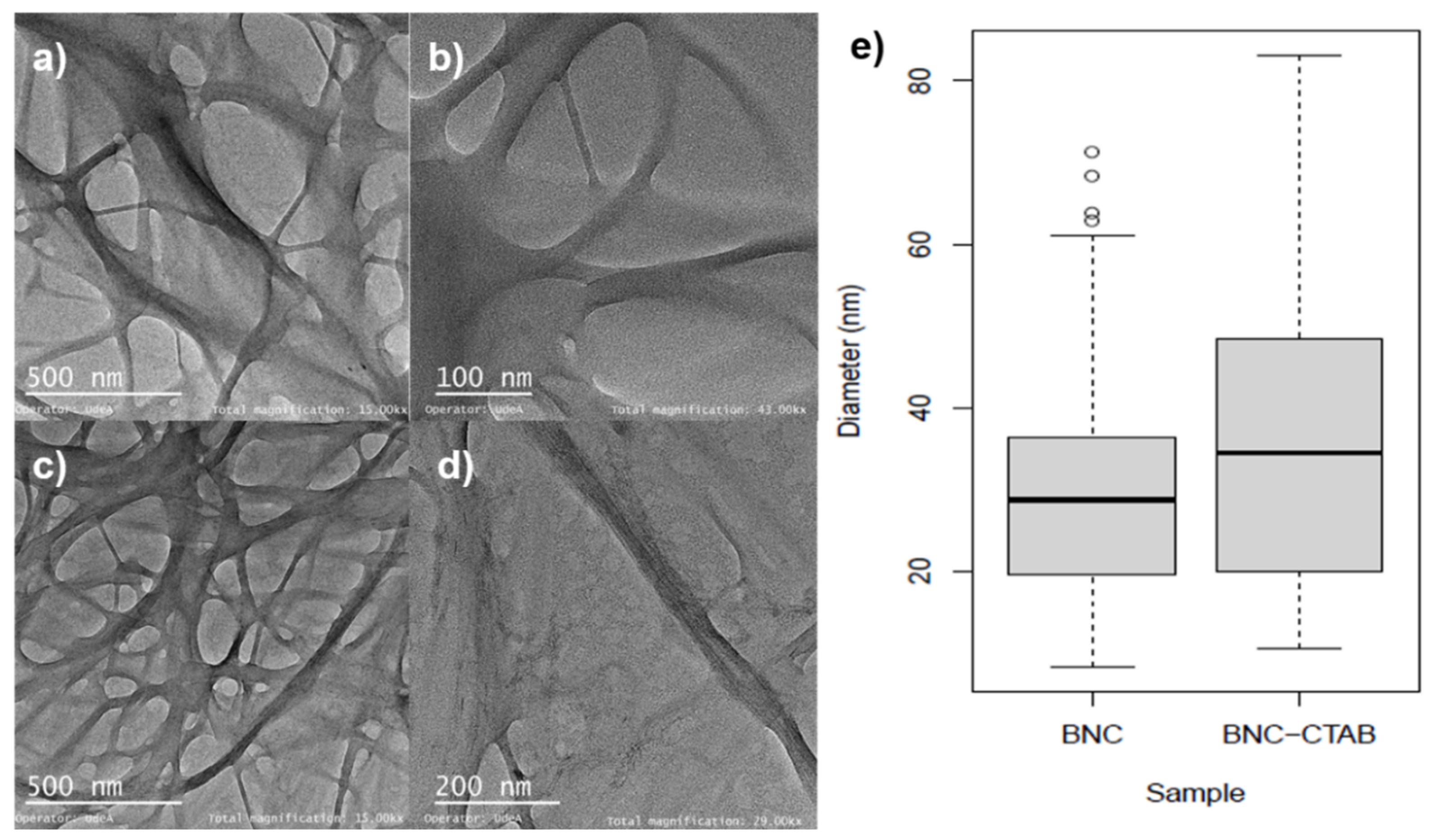
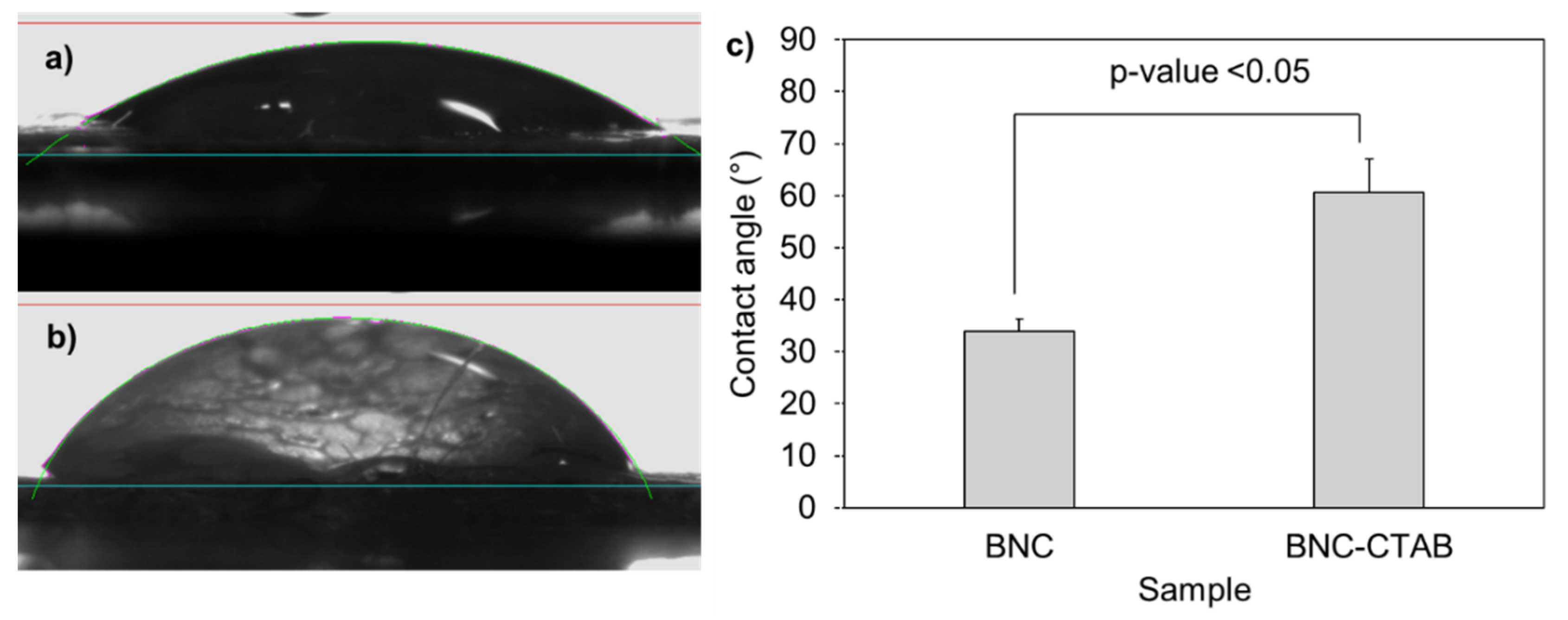

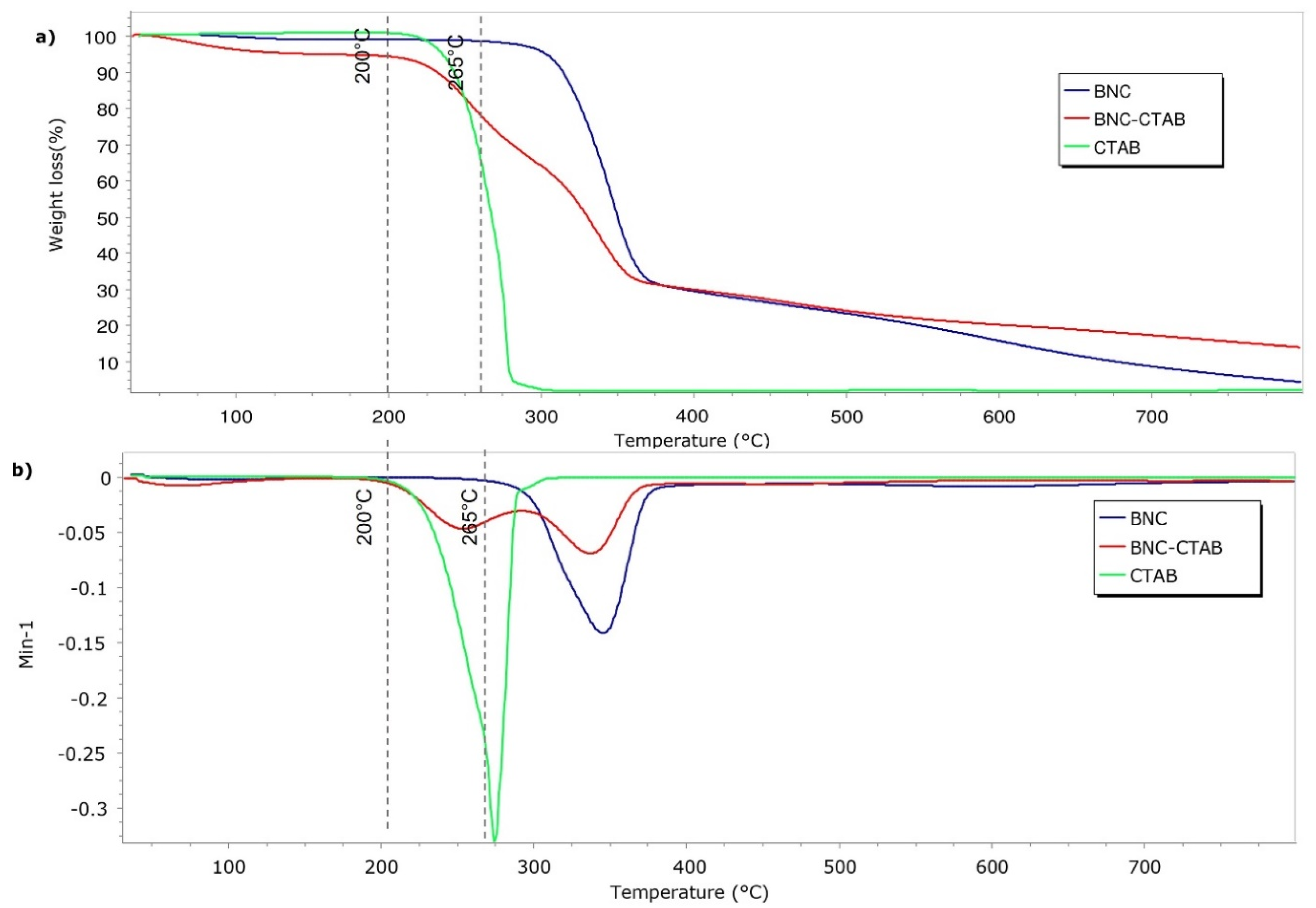
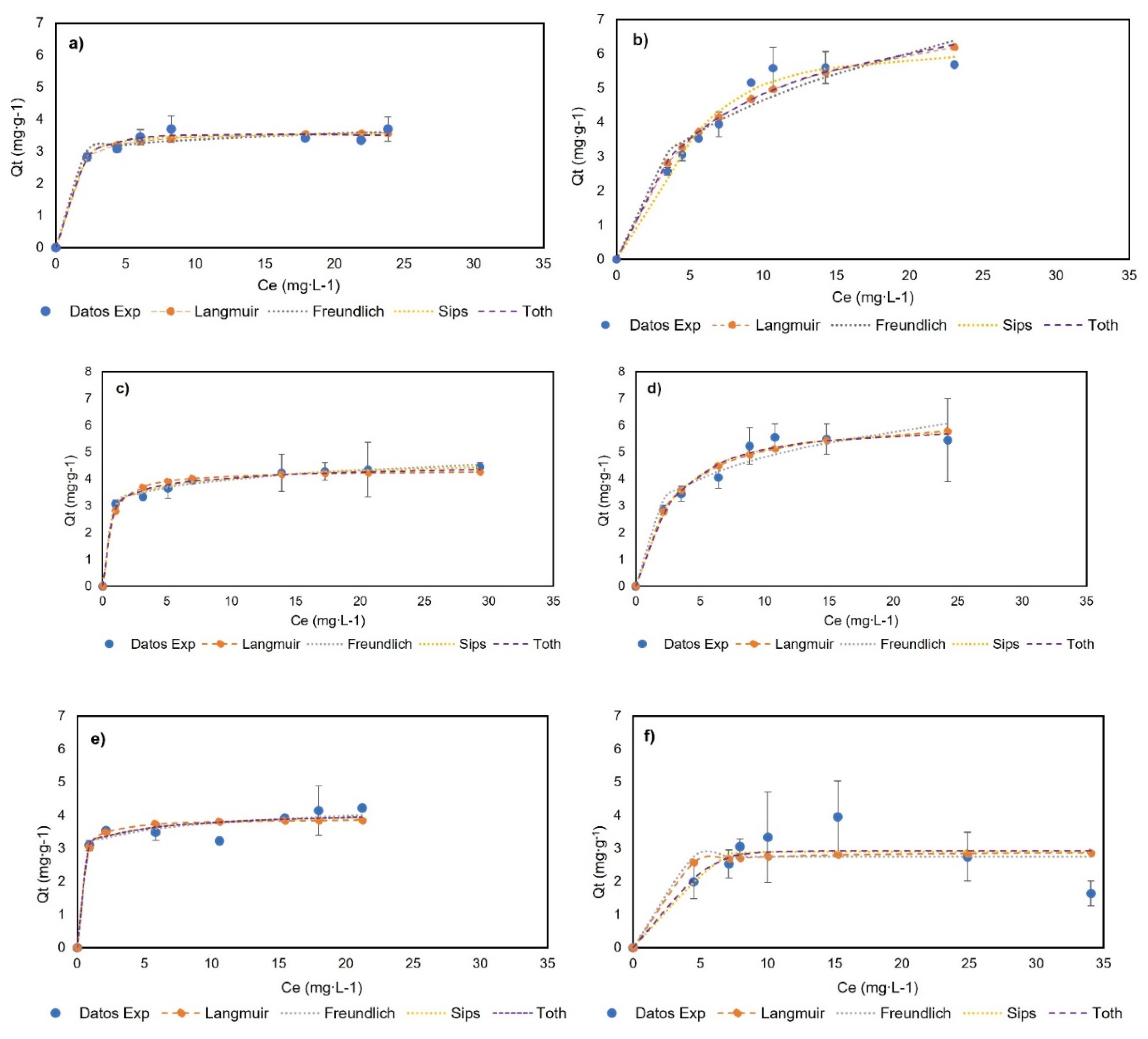

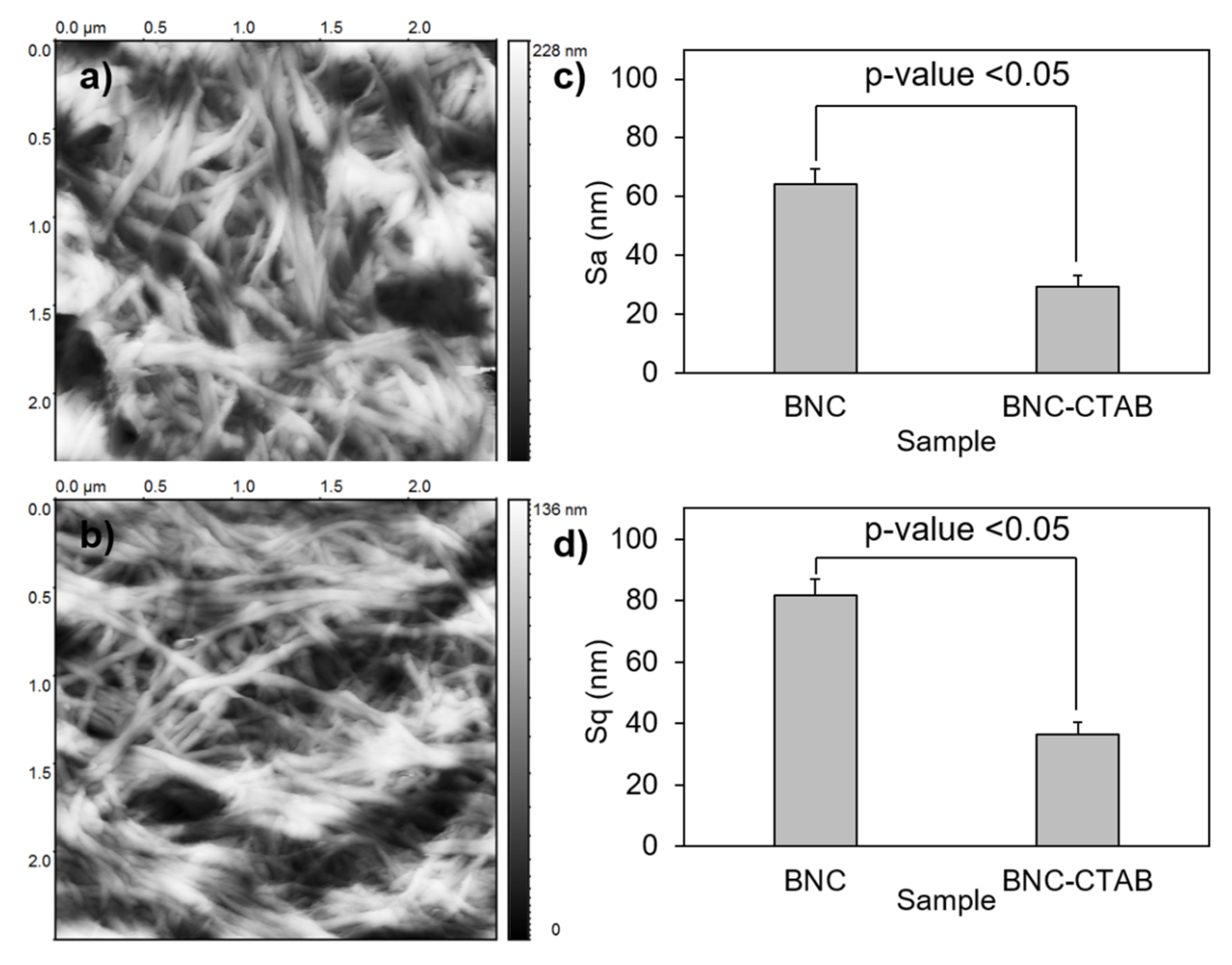

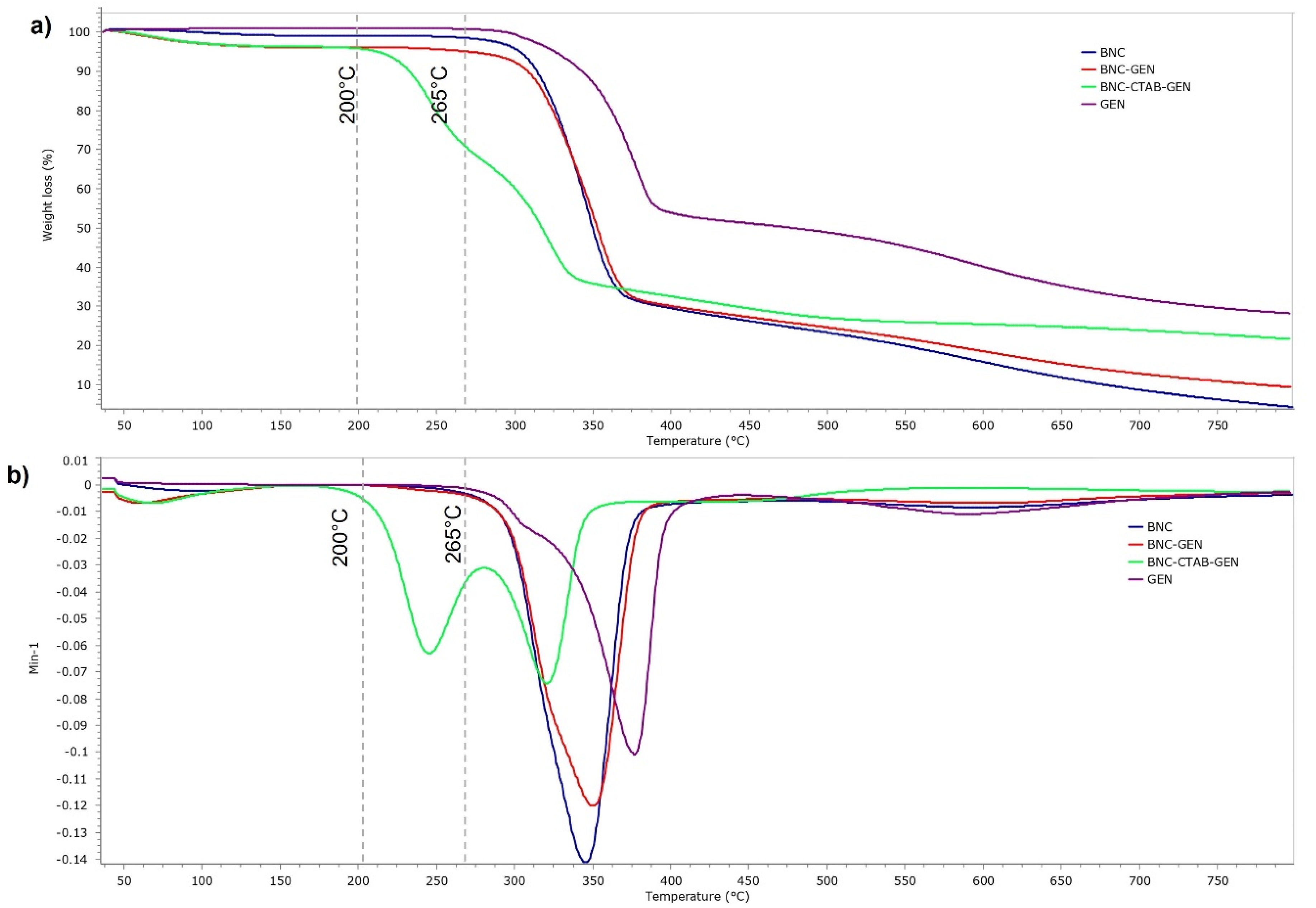
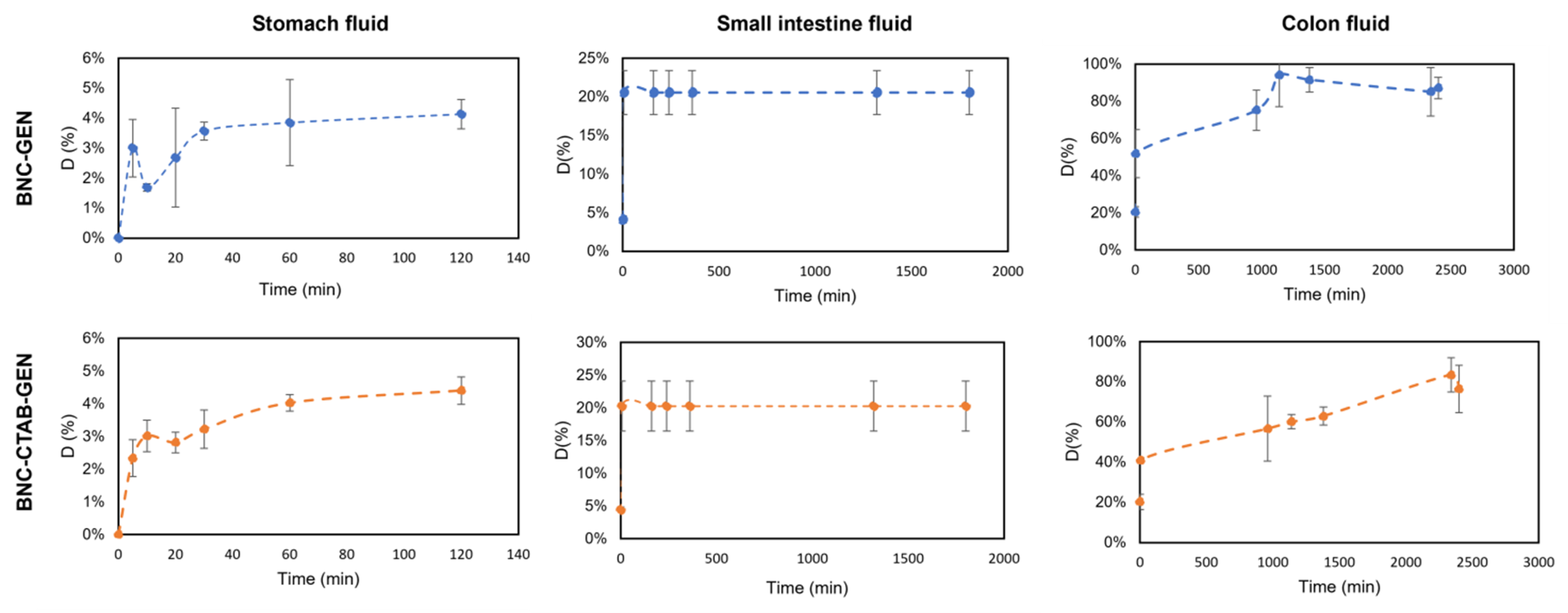
| Isotherm Models | BNC-GEN | BNC-CTAB-GEN | |||||
|---|---|---|---|---|---|---|---|
| 0 °C | 23 °C | 40 °C | 0 °C | 23 °C | 40 °C | ||
| Langmuir | Qm (mg·g−1) | 3.67 | 4.34 | 3.90 | 8.12 | 6.47 | 2.92 |
| KL (L·mg−1) | 1.58 | 1.80 | 3.95 | 0.15 | 0.35 | 1.68 | |
| R2 | 0.98 | 0.98 | 0.95 | 0.96 | 0.98 | 0.65 | |
| Freundlich | KF | 8.12 | 3.04 | 3.11 | 1.88 | 2.63 | 2.75 |
| 0.15 | 8.44 | 12.13 | 2.53 | 3.81 | 4.30 × 107 | ||
| R2 | 0.96 | 0.99 | 0.97 | 0.92 | 0.95 | 0.64 | |
| Sips | QmS (mg·g−1) | 3.56 | 5.56 | 4.63 | 6.24 | 6.12 | 2.91 |
| aS (L·mg−1) | 0.96 | 1.12 | 2.07 | 0.05 | 0.31 | 0.00 | |
| BS | 1.65 | 0.37 | 0.33 | 2.00 | 1.20 | 5.87 | |
| R2 | 0.98 | 0.99 | 0.96 | 0.98 | 0.98 | 0.71 | |
| Toth | QmT (mg·g−1) | 4.47 | 4.84 | 4.99 | 6.55 | 5.99 | 2.93 |
| AT (L·mg−1) | 0.65 | 3.48 | 8.49 | 0.24 | 0.17 | 0.00 | |
| z | 1.09 | 0.50 | 0.24 | 0.92 | 1.38 | 5.14 | |
| R2 | 0.99 | 0.99 | 0.96 | 0.95 | 0.98 | 0.71 | |
| BNC-GEN | |||
|---|---|---|---|
| T (°C) | ΔG (kJ∙mol−1) | ΔH (kJ∙mol−1) | ΔS (J∙mol−1∙K−1) |
| 0 | −29.45 | 15.21 | 162.58 |
| 23 | −32.25 | ||
| 40 | −36.14 | ||
| BNC-CTAB-GEN | |||
| T (°C) | ΔG (kJ∙mol−1) | ΔH (kJ∙mol−1) | ΔS (J∙mol−1∙K−1) |
| 0 | −24.099 | 41.36 | 238.33 |
| 23 | −28.225 | ||
| 40 | −33.913 | ||
| Pseudo-First-Order | Pseudo-Second-Order | ||||
| Parameters | BNC-GEN | BNC-CTAB-GEN | Parameters | BNC-GEN | BNC-CTAB-GEN |
| Qe (mg∙g−1) | 3.46 | 5.98 | Qe (mg∙g−1) | 4.05 | 6.16 |
| K1 (min−1) | 0.08 | 0.39 | K2 (g∙mg−1∙min−1) | 0.02 | 0.15 |
| R2 | 0.70 | 0.94 | R2 | 0.75 | 0.96 |
| Elovich | Intra-Particle Diffusion | ||||
| Parameters | BNC-GEN | BNC-CTAB-GEN | Parameters | BNC-GEN | BNC-CTAB-GEN |
| α (mg∙g−1∙min−1) | 0.845 | 4.15 × 106 | C (mg∙L−1) | 0.53 | 3.07 |
| β (g∙mg−1) | 1.27 | 3.431 | K3 (mg∙g−1∙min−1/2) | 0.33 | 0.35 |
| R2 | 0.62 | 0.364 | R2 | 0.78 | 0.48 |
| Models | Stomach Fluid | Small Intestine Fluid | Colon Fluid | ||||
|---|---|---|---|---|---|---|---|
| BNC-GEN | BNC-CTAB-GEN | BNC-GEN | BNC-CTAB-GEN | BNC-GEN | BNC-CTAB-GEN | ||
| PFO | Qd (mg∙g−1) | 1.62 | 2.63 | 10.68 | 16.05 | 42.10 | 50.46 |
| K1 (min−1) | 3.29 | 12.00 | 1.78 | 1.78 | 0.16 | 12.00 | |
| R2 | 0.68 | 0.75 | 0.93 | 0.91 | 0.98 | 0.94 | |
| PSO | Qd (mg∙g−1) | 2.19 | 3.64 | 11.68 | 17.32 | 44.46 | 63.70 |
| K2 (g∙mg−1∙min−1) | 6.59 × 102 | 4.11 × 10−2 | 6.18 × 10−4 | 4.88 × 10−4 | 4.28 × 10−4 | 9.38 × 10−5 | |
| h (mg∙g−1∙min−1) | 0.32 | 0.54 | 0.08 | 0.15 | 0.85 | 0.38 | |
| R2 | 0.98 | 0.99 | 0.93 | 0.95 | 0.99 | 0.96 | |
| Sample | Genistein Concentration (mg∙L−1) | Adsorbent Concentration (%) |
|---|---|---|
| GE9 | 65.34 | 0.5 |
| GE8 | 51.48 | 0.5 |
| GE7 | 42.28 | 0.5 |
| GE6 | 38.64 | 0.5 |
| GE5 | 35.00 | 0.5 |
| GE4 | 26.72 | 0.5 |
| GE3 | 23.26 | 0.5 |
| GE2 | 19.80 | 0.5 |
| GE1 | 16.34 | 0.5 |
| GE0 | 0.00 | 0.5 |
| Model | Parameters | Description |
|---|---|---|
| Langmuir | , maximum adsorption capacity (mg∙g−1) , Langmuir constant (L∙mg−1). | Assumes monolayer adsorption and homogeneous surface. Additionally, adsorption is localized. |
| Freundlich | , Freundlich constant (mg1−n∙Ln∙g−1) , adsorption intensity | Describes a heterogeneous surface of adsorption with the interaction between adsorbed molecules. |
| Sips | , maximum adsorption capacity (mg∙g−1) , Sips constant (L∙mg−1) , model exponent | Describes heterogeneous systems, localized adsorption without adsorbate–adsorbate interactions. is known as the heterogeneity factor. |
| Toth | , maximum adsorption capacity (mg∙g−1) , Toth constant (L∙mg−1) , model exponent | Describes heterogeneous systems. Parameter z is related to system heterogeneity. |
Publisher’s Note: MDPI stays neutral with regard to jurisdictional claims in published maps and institutional affiliations. |
© 2022 by the authors. Licensee MDPI, Basel, Switzerland. This article is an open access article distributed under the terms and conditions of the Creative Commons Attribution (CC BY) license (https://creativecommons.org/licenses/by/4.0/).
Share and Cite
Castaño, M.; Martínez, E.; Osorio, M.; Castro, C. Development of Genistein Drug Delivery Systems Based on Bacterial Nanocellulose for Potential Colorectal Cancer Chemoprevention: Effect of Nanocellulose Surface Modification on Genistein Adsorption. Molecules 2022, 27, 7201. https://doi.org/10.3390/molecules27217201
Castaño M, Martínez E, Osorio M, Castro C. Development of Genistein Drug Delivery Systems Based on Bacterial Nanocellulose for Potential Colorectal Cancer Chemoprevention: Effect of Nanocellulose Surface Modification on Genistein Adsorption. Molecules. 2022; 27(21):7201. https://doi.org/10.3390/molecules27217201
Chicago/Turabian StyleCastaño, Melissa, Estefanía Martínez, Marlon Osorio, and Cristina Castro. 2022. "Development of Genistein Drug Delivery Systems Based on Bacterial Nanocellulose for Potential Colorectal Cancer Chemoprevention: Effect of Nanocellulose Surface Modification on Genistein Adsorption" Molecules 27, no. 21: 7201. https://doi.org/10.3390/molecules27217201
APA StyleCastaño, M., Martínez, E., Osorio, M., & Castro, C. (2022). Development of Genistein Drug Delivery Systems Based on Bacterial Nanocellulose for Potential Colorectal Cancer Chemoprevention: Effect of Nanocellulose Surface Modification on Genistein Adsorption. Molecules, 27(21), 7201. https://doi.org/10.3390/molecules27217201







